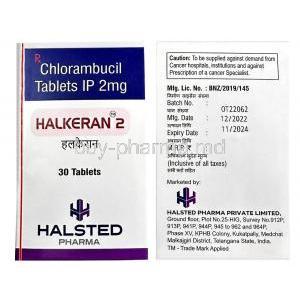Introduction
Dacarbazine stands as a pivotal chemotherapeutic agent, primarily wielded in the battle against malignant neoplasms. This compound's journey from its synthesis to its current status as a cornerstone in oncology highlights a significant evolution in cancer treatment modalities. Initially developed in the mid-20th century, Dacarbazine's efficacy in stalling the proliferation of cancer cells has rendered it a vital tool in oncological arsenals.
Composition of Dacarbazine Injection
Active Ingredient Analysis:
At the core of Dacarbazine's formulation is an alkylating agent that functions by introducing alkyl groups into DNA strands, thus disrupting the cancer cells’ lifecycle.
List of Excipients:
The injection also contains several excipients such as dimethylacetamide and mannitol, which serve to stabilize the formulation and enhance its pharmacokinetic profile.
Uses of Dacarbazine
Dacarbazine is endorsed for its therapeutic prowess in managing various neoplastic disorders. It is predominantly prescribed for:
Primary Indications in Cancer Treatment:
Its primary use has been in treating malignant melanoma and Hodgkin's lymphoma.
Specific Cancers Treated:
Apart from its main indications, it is also utilized in the treatment of soft tissue sarcoma and is under investigation for other types of cancer.
Off-Label Uses of Dacarbazine
While Dacarbazine is approved for specific types of cancers, its efficacy has prompted oncologists to employ it in treating other conditions as well, though these uses are not officially sanctioned:
Exploring Non-Approved Indications:
Studies are ongoing to assess its potential in combating neuroendocrine tumors and other rare malignancies.
How Dacarbazine Works
The therapeutic efficacy of Dacarbazine stems from its intricate mechanism of action:
Mechanism of Action in Cancer Cells:
It acts as a purine analogue, misleading cancer cells into incorporating these fraudulent molecules into their DNA during replication, leading to the cells’ ultimate demise.
Pharmacodynamics and Pharmacokinetics:
Dacarbazine exhibits a dynamic absorption and metabolism profile, metabolized primarily in the liver and excreted via the kidneys, affecting both rapidly dividing and static tumor cells.
Dosage and Administration
Administering Dacarbazine requires adherence to precise dosing protocols:
Standard Dosing Guidelines:
The dosage is tailored based on the type and stage of cancer, generally administered intravenously during chemotherapy cycles.
Modifications for Different Age Groups and Body Sizes:
Dosage adjustments are crucial for optimizing therapeutic outcomes while minimizing adverse effects, particularly in pediatric and geriatric patients.
Administration to Specific Populations
Administration to Elderly Patients
Elderly patients necessitate cautious dose adjustments and continuous monitoring due to the increased risk of complications:
- Adjustments and Considerations: Reduced dosages are often imperative to accommodate the physiological changes associated with aging.
Administration to Pregnant Women and Nursing Mothers
Concerns about the teratogenic effects of Dacarbazine necessitate stringent guidelines:
- Safety Profile and Recommendations: It is generally contraindicated, with use only considered if the benefits justify the potential risks to the fetus or neonate.
Administration to Children
Pediatric oncology demands specialized dosing strategies to ensure safety and efficacy:
- Dose Adjustments and Efficacy: Careful calibration of dosage is essential to mitigate adverse effects while maintaining therapeutic efficacy in juvenile patients.
Side Effects of Dacarbazine
Common Side Effects
Dacarbazine therapy is often accompanied by a spectrum of side effects, which, while generally manageable, can impact patient comfort and treatment adherence:
- Nausea and vomiting, frequently managed with antiemetics.
- Fatigue and malaise, common yet often underreported by patients.
- Alopecia and skin changes, which can affect self-esteem and necessitate supportive care.
Effective management of these symptoms is critical to maintaining the quality of life and can often be achieved through adjunct therapies and supportive measures.
Serious Adverse Effects
The occurrence of severe side effects demands immediate attention:
- Severe myelosuppression can lead to life-threatening infections.
- Hepatotoxicity, which requires regular liver function monitoring.
- Anaphylactic reactions, necessitating emergency interventions.
Healthcare providers must be adept at identifying these risks early and responding with appropriate emergency care to prevent significant morbidity.
Important Precautions
Utilizing Dacarbazine safely involves recognizing several pharmacological landscapes:
- Interactions with other medications can alter Dacarbazine's effectiveness and toxicity, necessitating careful review of patient medication histories.
- Contraindications such as existing liver or kidney impairment may preclude its use, while certain genetic conditions require dose adjustments or alternative therapies.
Handling and Storage
Ensuring the integrity of Dacarbazine involves stringent handling and storage protocols:
- Proper storage conditions typically require refrigeration and protection from light to maintain chemical stability.
- Handling precautions include the use of protective clothing and training in spill management to prevent occupational exposure.
Overdose Management
An overdose of Dacarbazine, although rare, requires swift and decisive action:
- Symptoms of overdose might include exacerbated side effects such as extreme nausea or severe myelosuppression.
- Immediate actions include the administration of supportive care and potential antidotes, alongside monitoring vital signs and blood counts.
Warnings and Contraindications
Prior to initiating therapy with Dacarbazine, certain warnings and contraindications must be communicated:
- Specific patient warnings might relate to potential allergic reactions or the increased risk of secondary malignancies.
- Absolute contraindications can include conditions like severe bone marrow suppression or known hypersensitivity to the drug or its components.
Drug Interactions
The clinical efficacy and toxicity of Dacarbazine can be influenced by drug interactions:
- Pharmacological interactions with drugs such as CYP450 inducers or inhibitors can significantly alter Dacarbazine's metabolic profile.
- These interactions may necessitate dosage adjustments or even the selection of alternative therapeutic agents to avoid adverse effects.
Careful Administration
The administration of Dacarbazine demands meticulous attention to detail:
- Guidelines for safe administration encompass proper technique for intravenous infusion and premedication to mitigate nausea.
- Monitoring and support during treatment are crucial to detect early signs of adverse reactions and to ensure therapeutic efficacy while minimizing side effects.





















